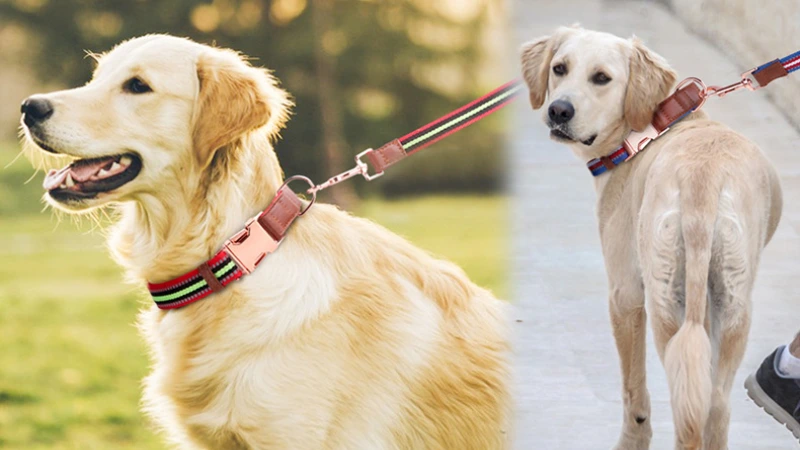Are you struggling to keep your dog secure during walks? Do you have a breed with a narrow head that easily slips out of regular collars? If so, a martingale collar might be the solution you’re looking for. This guide will walk you through everything you need to know about fitting and using a martingale collar, ensuring your dog stays safe and comfortable during walks and training sessions.
1. Why choose a martingale collar?
Before we dive into the how-to’s, let’s understand why martingale collars are gaining popularity among dog owners. These collars offer several advantages that make them stand out from traditional collars:
Safety first
Imagine you’re walking your greyhound, and suddenly, they spot a squirrel. With a regular collar, they might slip right out and dash off. Martingale collars prevent this common problem. They’re designed with a unique double-loop system that tightens slightly when your dog pulls, but not enough to choke them. This makes them especially useful for breeds with narrow heads compared to their necks, like greyhounds, whippets, and some terriers.
Better control without the harm
Have you ever felt like you’re in a constant tug-of-war with your dog during walks? Martingale collars can help. When your dog pulls, the collar tightens just enough to discourage the behavior. It’s like giving them a gentle reminder to walk nicely, without causing any pain or discomfort. This makes it an effective training tool, especially for dogs that tend to pull on the leash.
Comfort is key
Unlike choke collars that can restrict breathing, martingale collars are designed with your dog’s comfort in mind. They sit loosely around your dog’s neck when there’s no tension on the leash. Even when tightened, they don’t constrict excessively, allowing your dog to breathe normally. This means your furry friend can enjoy walks without feeling uncomfortable or stressed.
Versatility for the win
One collar for training and everyday walks? Yes, please! Martingale collars are versatile enough to be used in various situations. Whether you’re working on leash training or just going for a casual stroll, this collar has got you covered. This versatility makes it a cost-effective choice for dog owners, saving you from buying multiple types of collars for different purposes.
2. How to fit a martingale collar: step-by-step fitting guide
Now that you understand the benefits, let’s get down to the nitty-gritty of fitting a martingale collar. A properly fitted collar is crucial for its effectiveness and your dog’s comfort. Follow these steps to ensure you get it right:
Step 1: Measure your dog’s neck
First things first, you need to know your dog’s neck size. Here’s how:
- Get a soft measuring tape. If you don’t have one, use a string and then measure it against a ruler.
- Find the widest part of your dog’s neck. This is usually just below the ears and above the shoulders.
- Wrap the measuring tape or string around this part of the neck.
- If using a string, mark where it overlaps and measure this length with a ruler.
- Write down this measurement. You’ll need it when selecting your collar size.
Pro tip: Add about 2 inches (5 cm) to this measurement. This extra space ensures the collar isn’t too tight and allows for some adjustment.
Step 2: Choose the right size
With your dog’s neck measurement in hand, it’s time to select the right collar size. Most martingale collars come in sizes like small, medium, and large, with a range of neck measurements for each size. Choose a size that includes your dog’s neck measurement plus the 2-inch allowance.
For example, if your dog’s neck measures 14 inches:
- Add 2 inches for comfort = 16 inches
- Look for a collar size that includes 16 inches in its range (e.g., “Medium: 14-18 inches”)
Step 3: Adjust the collar
Now that you have the right size, it’s time to put it on your dog:
- Unfasten the collar and place it around your dog’s neck.
- The larger loop should be the main part that sits loosely around the neck.
- The smaller loop (control loop) should be positioned on top of the neck. This is the part that will tighten when the leash is pulled.
- Fasten the collar, making sure it’s not too tight or too loose.
Step 4: Test the fit
Here’s where you make sure the collar is doing its job:
- Slide the collar over your dog’s head. It should fit over the largest part of the head with a little resistance, but not be so tight that it’s difficult to put on or take off.
- With the collar on, check that you can comfortably fit two fingers between the collar and your dog’s neck. This ensures it’s not too tight.
- Gently pull on the leash attachment ring. The collar should tighten slightly but not choke your dog. If the two metal rings on the control loop touch when you pull, the collar is too loose and needs to be tightened.
- Watch your dog’s reaction. They shouldn’t show signs of discomfort or try to paw at the collar.
Step 5: Final adjustments
Based on your test fit, make any necessary adjustments:
- If the collar is too loose, tighten it by adjusting the slider on the larger loop.
- If it’s too tight, loosen it slightly.
- Double-check that the control loop is positioned correctly on top of the neck.
Remember, a properly fitted martingale collar should be snug enough to prevent escape but loose enough for comfort when not in use.
How to use a martingale collar correctly
Now that you’ve got the perfect fit, let’s talk about how to use your martingale collar effectively. Using it correctly ensures your dog’s safety and helps you get the most out of this versatile tool.
Leash attachment: the key to success
Always attach the leash to the D-ring on the smaller loop (the control loop). This is crucial because it ensures the collar functions as intended. When you attach the leash here, any tension will cause the collar to tighten evenly around your dog’s neck, providing gentle pressure without choking.
Common mistake to avoid: Don’t attach the leash to the larger loop or any other part of the collar. This will prevent the martingale mechanism from working properly, defeating the purpose of using this type of collar.
Training: your new walking buddy
Martingale collars shine as training tools, especially for dogs that tend to pull on the leash. Here’s how to use it effectively:
- Start with short walks in a quiet area to get your dog used to the new collar.
- When your dog starts to pull, stop walking. The collar will tighten slightly, signaling your dog to stop pulling.
- Wait for your dog to return to your side or loosen the leash tension.
- Reward your dog with praise or a small treat when they walk nicely without pulling.
- Repeat this process consistently. Most dogs learn to walk without pulling within 2-3 weeks of consistent training.
Remember, the goal is to teach your dog that walking nicely beside you is rewarding, not to rely on the collar’s tightening action to control them.
Monitoring: keep an eye out
While martingale collars are generally safe, it’s important to monitor your dog’s behavior and the collar’s performance:
- Watch for signs of discomfort like excessive scratching, whining, or attempts to remove the collar.
- Check the fit regularly, especially for growing puppies or dogs that gain or lose weight.
- Inspect the collar for signs of wear and tear. Replace it if you notice fraying, loose stitching, or damaged hardware.
Pro tip: Remove the collar when your dog is in their crate or playing unsupervised with other dogs to prevent any risk of it getting caught.
Off-leash no-no
Martingale collars are not designed for off-leash use. Always remove the collar or switch to a regular flat collar when letting your dog off-leash. This prevents any risk of the collar getting caught on objects or other dogs during play.
Troubleshooting common issues
Even with proper fitting and use, you might encounter some challenges. Here’s how to address common issues:
Problem: Your dog still manages to slip out of the collar
Solution:
- Double-check the fit. The collar might be too loose.
- Adjust the collar so that when tightened, it’s snug but not choking.
- Ensure the control loop is positioned correctly on top of the neck.
- If problems persist, consider a slightly smaller size or consult a professional trainer.
Problem: Your dog shows signs of discomfort
Solution:
- Check for any rubbing or chafing on your dog’s neck.
- Ensure the collar isn’t too tight. You should be able to fit two fingers between the collar and your dog’s neck.
- Try loosening the collar slightly.
- If discomfort continues, your dog might have sensitive skin. Consider a padded martingale collar or explore alternative options with your vet.
Problem: Your dog isn’t responding to training with the martingale collar
Solution:
- Ensure you’re using positive reinforcement along with the collar. Reward good behavior consistently.
- Check that you’re using the collar correctly, attaching the leash to the proper ring.
- Be patient. Training takes time, often 2-4 weeks for noticeable improvement.
- If you’re not seeing progress after a month of consistent training, consult a professional dog trainer for personalized advice.
Problem: The collar seems to be wearing out quickly
Solution:
- Check the quality of the collar. Invest in a well-made collar from a reputable brand.
- Clean the collar regularly to remove dirt and oils that can break down the material.
- Remove the collar when your dog isn’t on a walk to reduce wear and tear.
- Replace the collar every 12-18 months or sooner if you notice significant wear.
Conclusion: walking toward success
Martingale collars offer a safe, effective solution for many dog owners struggling with leash control or escape artist pups. By following this guide, you’re well on your way to mastering the art of fitting and using a martingale collar.
Remember these key points:
- Measure carefully for the perfect fit.
- Use the collar as a training tool, not a restraint.
- Monitor your dog’s comfort and the collar’s condition regularly.
- Be patient and consistent in your training efforts.
With proper use, a martingale collar can transform your daily walks from a struggle to an enjoyable bonding experience with your furry friend. It’s not just about control; it’s about building trust and communication between you and your dog.
At Wedogy, we’re committed to providing high-quality pet products that make your life easier and your dog’s life better. Our martingale collars are designed with both safety and comfort in mind, perfect for dog owners looking for a reliable solution to their walking and training needs.





